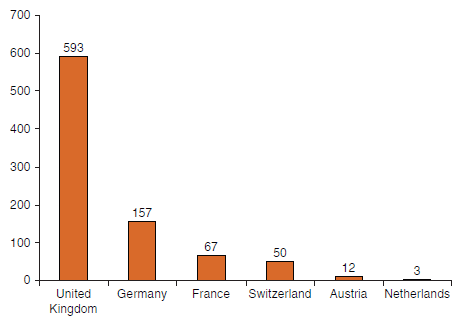1. In the United States, nearly two-thirds of Starbucks outlets are company owned; the remaining one-third is...
Question:
2. In response to the economic downturn, Starbucks launched a new line of instant coffee called VIA Ready Brew. The company also developed a breakfast value meal that costs less than $4. Do you agree with these decisions?
3. Should Starbucks enter the Italian coffeehouse market? Why or why not?
4. In the long run, which company is more likely to win the global €œcoffee wars,€ Starbucks or McDonald€™s?
5. Assess the prospects for the new Starbucks Reserve Roastery and Tasting Room initiative.
Starbucks has also been successful in other European countries, including the United Kingdom and Ireland. This success comes despite competition from local rivals such as Ireland€™s Insomnia Coffee Company and Bewley€™s and the fact that per capita consumption of roasted coffee in the two countries is the lowest in Europe. Starbucks currently has more than 1,200 outlets in Europe; that figure includes company-operated stores in Austria, France, Germany, the Netherlands, Switzerland, and the United Kingdom, as well as licensed locations in Greece, Russia, Spain, and the United Kingdom (see Figure 9-3). Scandinavia represents a major opportunity; for example, Finland leads all other countries in per person coffee consumption, at nearly 27 pounds per year. Nordic neighbors Norway and Sweden are also in the top five. To date, Starbucks has been slow to expand in the region. However, that is changing as Starbucks partners with Norway€™s Umoe Restaurant Group. Michelle Gass, the executive in charge of Starbucks€™ European unit, is determined to make Starbucks a household name in the region. In January 2004, Starbucks opened its first outlets in Paris. CEO Howard Schultz acknowledged that the decision to target France was a gutsy move; after all, café culture has long been an entrenched part of the city€™s heritage and identity. The French prefer dark espresso, and the conventional wisdom is that Americans don€™t know what good coffee is. As one Frenchman put it, €œAmerican coffee, it€™s only water. We call it jus des chaussette€”€˜sock juice.€™€ Also high on Starbucks CEO Schultz€™s wish list for Europe: an outside-the box coffee product that will enable him to open shops in Italy. €œThat€™s a dream that I have yet to accomplish,€ Schultz says. Some would say the CEO€™s dream could turn into a nightmare. After all, Italy€™s coffeehouse tradition dates back more than 400 years, and today more than 110,000 coffee bars are scattered the length and breadth of the peninsula. Sniffed a spokesman for one of Starbucks€™ European competitors, €œThe Italian café is a culture that the Americans have repackaged. They concentrate more on their image than the coffee.€
Starbucks Introduces Coffee Culture to China
Not surprisingly, Greater China€”including the mainland, Hong Kong, and Taiwan€”represents another strategic growth market for Starbucks. Starting with one café in Beijing at the China World Trade Center, which opened in 1999, today Starbucks operates more than 400 outlets in mainland China. Another 700 units are licensed locations in China, Hong Kong, and Taiwan. Plans call for a total of 1,500 outlets by 2015.
Starbucks has faced several different types of challenges in this part of the world. For one thing, China is a nation of tea drinkers. Also, government regulations initially forced the company to partner with local firms. After the regulations were eased, Starbucks stepped up its rate of expansion, focusing on €œTier One€ metropolitan areas such as Beijing and Shanghai.
Another challenge comes from the traditional Chinese teahouse. Indeed, one rival, Real Brewed Tea, aims to be €œthe Starbucks of tea.€ A related challenge is the perceptions and preferences of the Chinese, who do not care for coffee. Those who had tasted coffee were familiar only with the instant variety. Faced with one of global marketing€™s most fundamental questions€”adapt offerings for local appeal or attempt to change local tastes€” Starbucks hopes to educate the Chinese about coffee. Meanwhile, the company has rolled out new products€”for example, red bean Frappuccino and a Hainan chicken and rice wrap€”that are designed to appeal to local tastes.
Figure 9-3

Step by Step Answer:






